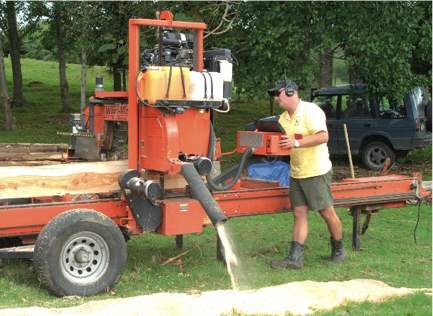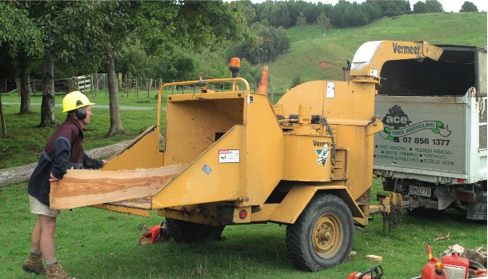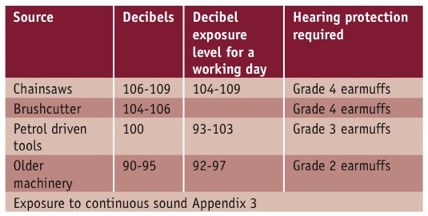Obey the safety rules
Dave Gratton, New Zealand Tree Grower August 2007.
Personal protective equipment (PPE) or, in the kiwi terminology, safety gear. Whatever you call it, PPE is designed for only one purpose, and that is to protect you from harm.
However in far too many instances PPE is not being used, so that when something from out of the ordinary happens there is nothing to cushion you, or prevent you from being hurt and damaged.
 The Approved Code of Practice Safety and Health in Forest Operations is the rulebook that OSH and all forest workers must abide by. On the back cover it states:
The Approved Code of Practice Safety and Health in Forest Operations is the rulebook that OSH and all forest workers must abide by. On the back cover it states:
‘This approved code of practice sets out the statutory requirements, rules and provisions, based on preferred work practices, to ensure the safety and health of people working in the forest industry or those who may be affected by the work. It contains essential information for forest owners, forestry contractors, farm foresters, employers, supervisors, workers and others.’
At the present time the Forest Owners Association and OSH are reviewing the content but when you look at the section under PPE, we find the following sections. Please note the words used – if it says shall then it is mandatory.
General health
The employer shall provide or make provision for all appropriate clothing and personal protective clothing, footwear and personal protective equipment to protect employees from harm due to any hazard in the workplace, and ensure it is used correctly.
This rule means what it says. If an employee is to use a chainsaw then that worker must be trained in its use before the work starts.
There were two cases last year in agriculture where the courts heavily fined the employer, after an employee was badly cut on the head and chest from chainsaw kickback. In both cases no training in chainsaw safety had been given to the employee.
Leg protection
All workers required to use a chainsaw shall wear safety leg protection complying with AS/NZS 4453:1997 Protective clothing for users of hand-held chainsaws.
There are no ifs or buts about this rule – you pick up a chainsaw, you must wear the leg protection. And that is a good rule, as my own chap museum shows. When the unexpected happens these chainsaw chaps can save your legs from horrific damage.
Safety footwear
All workers engaged in forest operations shall wear footwear which
- Gives support to the ankles
- Has steel toe-caps complying with AS/NZS 2210 occupationalprotective footwear.
Laces shall be securely tied at all times.
Chainsaw safety footwear shall be of a recognised industry standard.
Steel toe-caps on your boots are there for a reason and that is to protect your toes from being cut.
 Safety helmets
Safety helmets
Safety helmets shall be worn at all times by persons who are
- Tree felling
- At a logging operation site
Exception: Machine operators who are fully protected by an approved canopy need not wear helmets.
- Safety helmets shall comply with AS/NZ 1801:1997 occupational protective helmets
- Safety helmets shall be of high visibility colours for daytime work
- Helmets shall be inspected regularly and shall be replaced as recommended by the manufacturer or earlier if they have suffered any damage or deterioration.
A good idea is to write the date of purchase inside the helmet. After three years of wear and tear and exposure to sunlight, then it needs to be retired and replaced.
Hearing protection
 Hearing protection shall be worn where noise levels are above, or likely to be above, 85Db.
Hearing protection shall be worn where noise levels are above, or likely to be above, 85Db.
- Hearing protection shall comply with the requirements as setout in Appendix 3: exposure to continuous sound
- Hearing protectors shall comply with * NZS/AS 1270:1988 Acoustics – hearing protectors.
- Owners of machinery shall take all practicable steps to minimise at source excessive noise levels, which may impair the workers hearing.
Earmuffs need to be checked regularly, and if showing signs of wear then replace them or the inner sections. Hearing loss is becoming a major problem in New Zealand costing ACC over $2 million in new claims each year. This figure is rapidly rising.
Eye protection
Eye protection shall be used where there is potential for injury
- Excessive dust
- Flying particles
- Material with vegetation
- Chemicals, welding and grinding
An exception can be applied where the eye protection itself is likely to cause a greater hazard. Note that chainsaw operators may use a forestry–type mesh visor.
Eye protection equipment other than forestry-type mesh visors shall comply with AS/NZS 1337:1992 Eye protectors for industrial applications.
During windy conditions it is easy to have dust or bark chips lodging into your eyes. Some people put in their first aid kit an eye wash container with a supply of clear water.
Safety belts and harnesses for silviculture
Safety belts and harnesses for silviculture and seed collection shall comply with AS/NZS 1891.1:1995 Industrial fall arrest systems and devices.
This rule applies to farm foresters if you are pruning over three metres height without formal qualifications in silviculture.
The Code of Practice also allows personal protective clothing, footwear and personal protective equipment as outlined above that complies with any other Standard embodying the same or more stringent criteria.

 Farm Forestry New Zealand
Farm Forestry New Zealand

